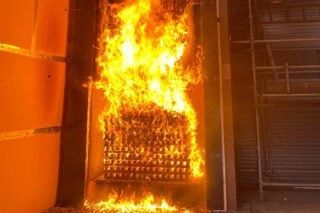Following an extensive research project involving insurers, the University of Central Lancashire, and external consultants, the FPA has developed RISC 501: Fire Test and Assessment Method for External Cladding Systems through RISCAuthority, an annually funded research scheme which conducts research on behalf of the insurance sector.
The occurrence of large cladding system fires has been increasing since 1990, which is of particular concern as a building’s cladding system has the potential to spread fire around a building, bypassing the internal fire compartments.
Combustible cladding systems are approved on high-rise buildings in the UK by the performance-based route to compliance, using the BS 8414 test method and BR 135 assessment criteria.
However, several limitations have been identified with this route in relation to the appropriateness of the fuel source, test construction, construction detailing, assessment criteria, and availability of test results.
RISC 501 (freely available to download here) has been developed to address these limitations and evaluates the fire safety performance of non-loadbearing external cladding systems, going beyond the basic life safety standards with the aim of ensuring resilient systems that can effectively prevent vertical spread.
This new test method is intended to be conducted either alongside BS 8414 so that the results can confer compliance with BR 135 and RISC 501, or as a standalone assessment.
The key differences to the BS 8414 test are:
● Stricter construction criteria to ensure that the system installed during a fire test better represents the system installed on a real building.
● Stricter temperature criteria designed to identify systems which can prevent vertical fire spread to multiple floors, rather than measuring an ‘acceptable’ rate of fire spread.
● Introduction of mechanical performance criteria designed to assess systems which could impede evacuation and firefighting operations.
● Introduction of gas sampling criteria as smoke toxicity is an emerging issue and must be measured to allow a comparison between cladding systems.
● Introduction of material fingerprinting for combustible products tested to allow a comparison between the products supplied for testing and those installed on a real building.
● Improved transparency by mandating that all test results must be published publicly which increases the availability of successful test results and prevents failed test results from being hidden.
The FPA’s Technical Director, George Edwardes has been at the forefront of the research: “There have been concerns around large scale cladding testing ever since its inception in the UK. “Conducting a thorough research project from an insurer’s perspective identified the areas that need improving and resulted in the development of a robust test method that reflects the built environment; a method that is appropriate for not just the minimum life safety requirement, but also for property protection.
The FPA and RISCAuthority recommend that systems are assessed against RISC 501 in addition to BS 8414 to wholly demonstrate their ability to prevent fire spread to multiple floors. RISC 501 testing is now available at the FPA’s laboratory.








